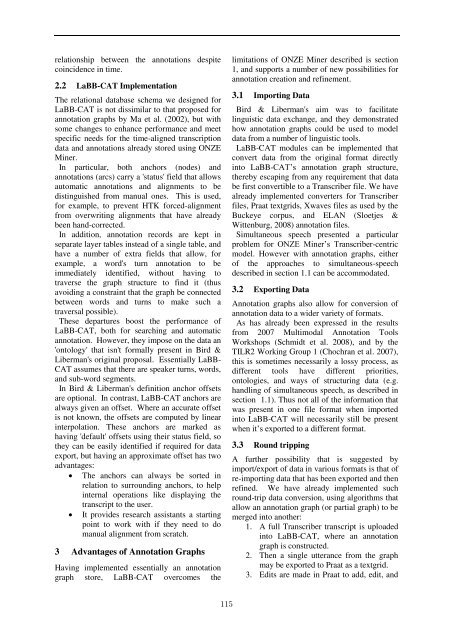Full proceedings volume - Australasian Language Technology ...
Full proceedings volume - Australasian Language Technology ...
Full proceedings volume - Australasian Language Technology ...
Create successful ePaper yourself
Turn your PDF publications into a flip-book with our unique Google optimized e-Paper software.
elationship between the<br />
coincidence in time.<br />
2.2 LaBB-CAT Implementation<br />
annotations despite<br />
The relational database schema we designed for<br />
LaBB-CAT is not dissimilar to that proposed for<br />
annotation graphs by Ma et al. (2002), but with<br />
some changes to enhance performance and meet<br />
specific needs for the time-aligned transcription<br />
data and annotations already stored using ONZE<br />
Miner.<br />
In particular, both anchors (nodes) and<br />
annotations (arcs) carry a 'status' field that allows<br />
automatic annotations and alignments to be<br />
distinguished from manual ones. This is used,<br />
for example, to prevent HTK forced-alignment<br />
from overwriting alignments that have already<br />
been hand-corrected.<br />
In addition, annotation records are kept in<br />
separate layer tables instead of a single table, and<br />
have a number of extra fields that allow, for<br />
example, a word's turn annotation to be<br />
immediately identified, without having to<br />
traverse the graph structure to find it (thus<br />
avoiding a constraint that the graph be connected<br />
between words and turns to make such a<br />
traversal possible).<br />
These departures boost the performance of<br />
LaBB-CAT, both for searching and automatic<br />
annotation. However, they impose on the data an<br />
'ontology' that isn't formally present in Bird &<br />
Liberman's original proposal. Essentially LaBB-<br />
CAT assumes that there are speaker turns, words,<br />
and sub-word segments.<br />
In Bird & Liberman's definition anchor offsets<br />
are optional. In contrast, LaBB-CAT anchors are<br />
always given an offset. Where an accurate offset<br />
is not known, the offsets are computed by linear<br />
interpolation. These anchors are marked as<br />
having 'default' offsets using their status field, so<br />
they can be easily identified if required for data<br />
export, but having an approximate offset has two<br />
advantages:<br />
The anchors can always be sorted in<br />
relation to surrounding anchors, to help<br />
internal operations like displaying the<br />
transcript to the user.<br />
It provides research assistants a starting<br />
point to work with if they need to do<br />
manual alignment from scratch.<br />
3 Advantages of Annotation Graphs<br />
Having implemented essentially an annotation<br />
graph store, LaBB-CAT overcomes the<br />
limitations of ONZE Miner described is section<br />
1, and supports a number of new possibilities for<br />
annotation creation and refinement.<br />
3.1 Importing Data<br />
Bird & Liberman's aim was to facilitate<br />
linguistic data exchange, and they demonstrated<br />
how annotation graphs could be used to model<br />
data from a number of linguistic tools.<br />
LaBB-CAT modules can be implemented that<br />
convert data from the original format directly<br />
into LaBB-CAT’s annotation graph structure,<br />
thereby escaping from any requirement that data<br />
be first convertible to a Transcriber file. We have<br />
already implemented converters for Transcriber<br />
files, Praat textgrids, Xwaves files as used by the<br />
Buckeye corpus, and ELAN (Sloetjes &<br />
Wittenburg, 2008) annotation files.<br />
Simultaneous speech presented a particular<br />
problem for ONZE Miner’s Transcriber-centric<br />
model. However with annotation graphs, either<br />
of the approaches to simultaneous-speech<br />
described in section 1.1 can be accommodated.<br />
3.2 Exporting Data<br />
Annotation graphs also allow for conversion of<br />
annotation data to a wider variety of formats.<br />
As has already been expressed in the results<br />
from 2007 Multimodal Annotation Tools<br />
Workshops (Schmidt et al. 2008), and by the<br />
TILR2 Working Group 1 (Chochran et al. 2007),<br />
this is sometimes necessarily a lossy process, as<br />
different tools have different priorities,<br />
ontologies, and ways of structuring data (e.g.<br />
handling of simultaneous speech, as described in<br />
section 1.1). Thus not all of the information that<br />
was present in one file format when imported<br />
into LaBB-CAT will necessarily still be present<br />
when it’s exported to a different format.<br />
3.3 Round tripping<br />
A further possibility that is suggested by<br />
import/export of data in various formats is that of<br />
re-importing data that has been exported and then<br />
refined. We have already implemented such<br />
round-trip data conversion, using algorithms that<br />
allow an annotation graph (or partial graph) to be<br />
merged into another:<br />
1. A full Transcriber transcript is uploaded<br />
into LaBB-CAT, where an annotation<br />
graph is constructed.<br />
2. Then a single utterance from the graph<br />
may be exported to Praat as a textgrid.<br />
3. Edits are made in Praat to add, edit, and<br />
115














